Wisconsin is one of the states with multiple butterfly species across dry and wet habitats.
Open fields and the edges of woodlands are some of the most common habitats for butterflies within the state.
Most butterflies here are only active until September, with just a few species remaining active until October.
One-brood butterflies are also common across the state.
A few butterflies are also known for migrating South for food and to avoid the colder winters in the North.
Wisconsin is also home to a few Canadian species such as the Canadian Tiger Swallowtail.
Rich in dogbane, milkweed, oak trees, and other nutritious plants and trees, Wisconsin offers the natural habitat many butterflies need to survive and reproduce.
Butterflies start to appear as soon as March-April, but most are seen later on from May-June.
Here are the most common species of butterflies seen in Wisconsin during the summer months.
Table of Contents
1. Monarch

Most Monarch butterflies (Danaus plexippus) grow to a wingspan between 3 and 4 inches.
Vivid contrasting colors are the main defense mechanisms of the species. Orange colors dominate its wings together with contrasting black colors.
This makes most predators associate Monarchs with a poisonous species.
These butterflies have a foul taste to predators that still decide to bite. This bad taste comes from the stored toxins, mostly from milkweed.
These butterflies can migrate over long distances for milkweed.
2. Silver-spotted Skipper

Silver-spotted Skipper butterflies (Epargyreus clarus) have very specific diets as caterpillars and even as adults.
These butterflies eat American hog-peanut, wisteria, and butterfly pea plants as caterpillars.
They then move on to plant nectar as adults. The adult Silver-spotted Skipper also eats mud, mainly by filtration nutrients from it.
These butterflies are also frequently seen feeding on dung.
Swamps are among the ideal habitats for Silver-spotted Skipper butterflies in the state.
3. Red-spotted Admiral

Red-spotted Admiral butterflies (Limenitis arthemis) have a black color with a V-shaped white band across the dorsal wings.
This species is categorized as a butterfly adapted to Batesian mimicry of Pipevine swallowtails. These are butterflies many predators stay away from.
Much time of the day is spent mating for the adult Red-spotted Admirals. Males tend to patrol areas with a higher number of females rather than chasing a single female butterfly.
4. Eastern Tiger Swallowtail

Seen feeding on red flowers across the state, Eastern Tiger Swallowtails (Papilio glaucus) are among the larger species of Wisconsin.
This butterfly has long wings it uses to propel itself and fly above the tree canopy.
The species favors nectar from various plants but it also often considers nutrition from other sources.
Males are known for eating mud.
You can identify this species by its base yellow color with black being its contrasting second color.
5. Black Swallowtail

Black Swallowtail butterflies (Papilio polyxenes) are known for high levels of aggression.
Male Black Swallowtails are aggressive between them, mainly for territorial control.
Both male and female Black Swallowtails are also known for mimicry coloring which is based on black and yellow dominant colors.
The caterpillars of the species are mostly green with black stripes and dots.
6. Great Spangled Fritillary

Violets are the host plant of the Great Spangled Fritillary (Speyeria cybele).
This species is identified by its contrasting orange and black coloring, and orange, black, and white ventral coloring.
A gradient coloring is specific to its dorsal wings. Darker orange nuances on its forewings turn to lighter nuances on the hindwings.
Large white spots with wide black borders are distinguished on the ventral wings of the species.
This butterfly has lighter orange nuances with black margins on the ventral wings.
7. Cabbage White

This type of butterfly (Pieris rapae) is a known pest across the state. The Cabbage White caterpillar is a pest of crucifers such as broccoli.
Birds are the most common predator of these caterpillars, but only in their late stages of development.
Adult Cabbage White butterflies are identified by their mostly white color with charcoal or black sections on the body and across the wings.
Cabbage White butterflies have pale green to white ventral wings. This color makes them more difficult to spot when resting on cabbages.
The species grows to a wingspan of at least 32mm.
8. Red Admiral

Red Admirals (Vanessa atalanta) are some of the largest butterflies in the state. The species has black, brown, orange, and white coloring.
Brown is the main color of the wings followed by black and then orange.
This species only mates based on the territorial traits of males.
Only males with proper territory control get to mate with females. This is why male Red Admirals fly multiple times per minute in their territory to assert dominance over other males.
Further Reading:
9. Northern Crescent
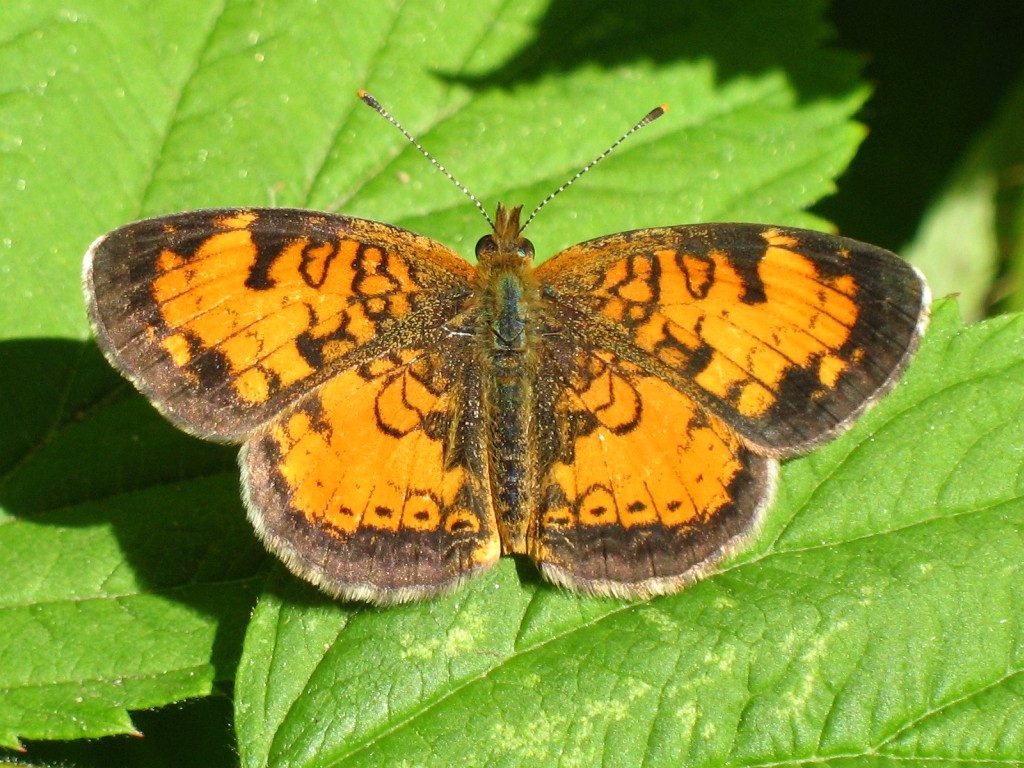
Asters are the main host flowers Northern Crescent butterflies (Phyciodes cocyta) are seen around the state.
Dogbane is a good source of nectar for adult Northern Crescent.
As the name implies, this species is mostly present in Northern US states.
Coloring differs from light to brown oranges with black veins and patterns.
The species has an average of 1 to 2 inches wingspan.
10. Eastern Tailed-Blue

Clovers are among the most common hosts of Eastern Tailed-Blue butterflies (Cupido comyntas). It’s a known pest on Wisconsin crops.
Growing to a maximum wingspan of up to 29mm, this butterfly has a light blue color on the ventral wings in the case of males.
Females have a dark gray to black color.
This species of butterflies absorbs toxins from the plants it consumes to have a bad taste for its common predators.
11. Viceroy

One of the most common butterflies in North America is also seen across Wisconsin.
Viceroy butterflies (Limenitis archippus) begin life on willows or other trees such as poplar.
It turns into a mostly orange adult butterfly with black veins and wide black margins.
Small white dots are seen across the margins of the wings.
Light orange colors are specific to the ventral wings of the species which also show black veins and black margins.
12. Karner Blue

Wild lupines are among the most common hosts for Karner Blue butterflies (Plebejus samuelis).
Adult Karner Blue butterflies have a base blue color across the dorsal wings with black and white margins.
Orange spots are seen on its lower hindwings.
Karner Blues are also among the species that feed on more than 40 plants for nectar, as adults.
This species can be attracted to gardens by planting native plants over imported plants.
13. Eastern Giant Swallowtail
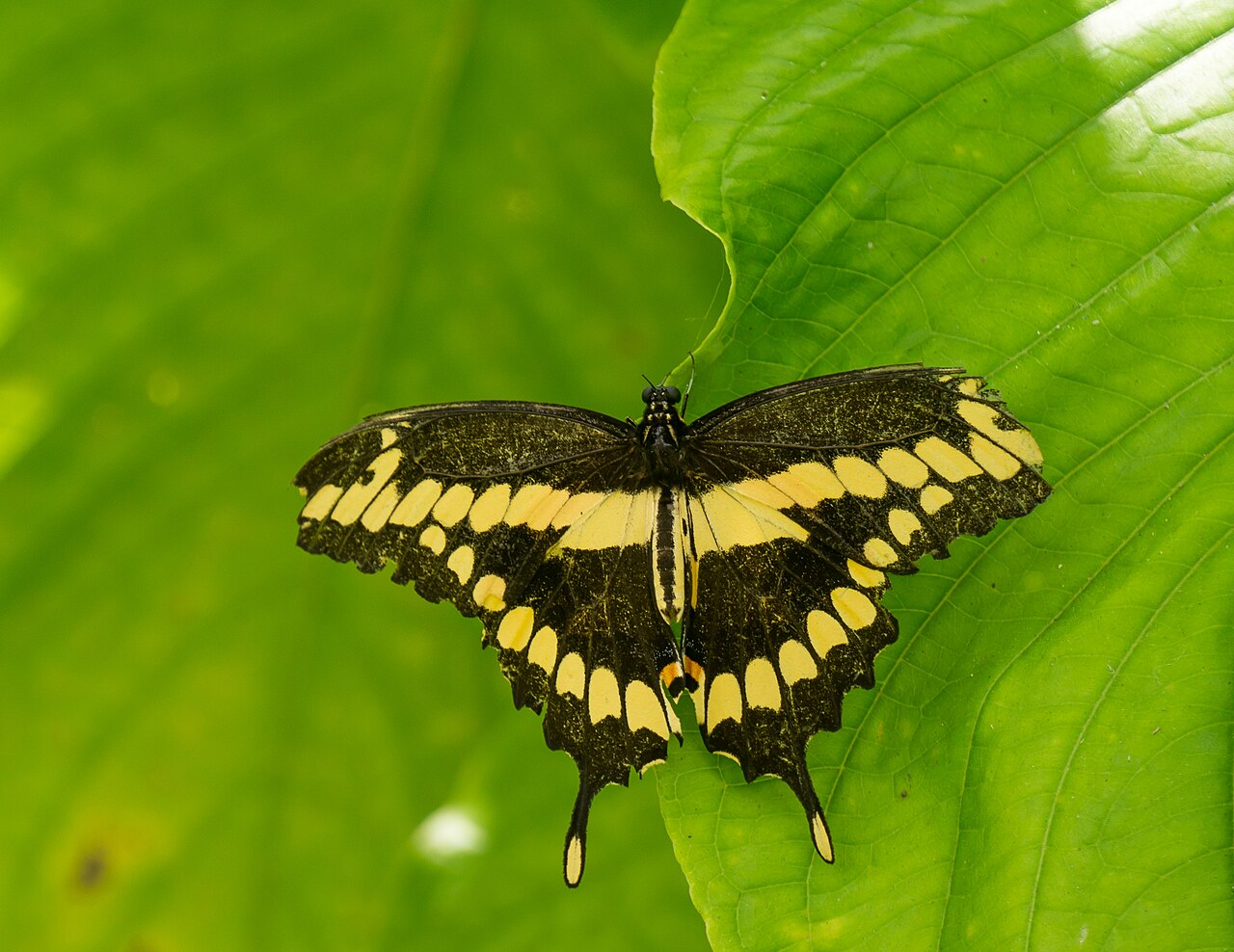
Eastern Giant Swallowtails (Papilio cresphontes) are some of the largest butterflies in the state. Dominated by black colors, these butterflies also exhibit yellow patches across the wings.
You can find Eastern Giant Swallowtails feeding on lantana. These butterflies also feed on yellow and red flowers.
Eastern Giant Swallowtails are also seen feeding on dung.
Parasitic wasps are the most important predators of these butterflies.
14. Mourning Cloak

Mourning Cloaks (Nymphalis antiopa) are dark butterflies that begin life as a 1-inch caterpillar.
Red spikes are seen across Mourning Cloak caterpillars.
This species then turns into an adult with hair front legs. Brown is the dominant color of its wings.
Its ventral wings are also dark. Brown and black colors are combined to make the species stand out less than others when its wings are closed.
15. Clouded Sulphur

Bright colors such as white and pale yellow are characteristic of Clouded Sulphur butterflies (Colias philodice).
This species is among the butterflies with a varying wingspan length which can reach 2 inches and above.
Pea family plants are the best place to see Clouded Sulphur butterflies in the state.
Open fields in sunny areas such as crops are also some of the favorites of these butterflies.
Alfafa is one of the plants most interesting for the species in these habitats.
16. Banded Hairstreak

Oak, hickory, and other hardwood trees are among the most common hosts of Banded Hairstreaks (Satyrium calanus).
These are host trees for Banded Hairstreak caterpillars.
Adults feed on plants rich in nectar such as dogbane and sweet clovers. They grow to an average wingspan of 1.5 inches.
This species has stable populations across the state.
You can see these butterflies flying in the summer, up until August.
17. Painted Lady

Painted Lady butterflies (Vanessa cardui) have multicolored orange, black, brown, and white wings.
The species has orange, black, white, and light brown color combinations across the dorsal wings.
These butterflies are known as migrators. They mate throughout the year both inside and outside of the state as they migrate South.
Migration patterns differ across Painted Lady butterflies. The species is capable of traveling thousands of miles to escape the cold winters in the North.
Overwintering is not specific to Painted Lady butterflies.
18. Northern Pearly-Eye

Northern Pearly-Eye butterflies (Lethe anthedon) begin life as green caterpillars.
They turn brown as they become adults. Dark brown coloring is specific to the dorsal wings while light brown colors are seen across the ventral wings.
Large black and brown eyespots are seen across the ventral side of the species.
Northern Pearly-Eye caterpillars feed on white-grasses while adults feed on sedges.
Known for their multiple eyespots on the dorsal and ventral wings, Northern Pearly-Eye butterflies are among the medium to large-sized species of the state.
These butterflies have a minimum wingspan of 43mm. Some of the larger individuals of the species can reach wingspans close to 70mm.
19. Pearl Crescent

Pearl Crescent butterflies (Phyciodes tharos) are seen from April to November across the state.
This species has a wingspan that can reach 34mm.
It’s characterized by orange and black colors with a black body.
You can find Pearl Crescent butterflies on various types of plants around the state. Some of the most common plants are dogbane and winter cress.
Adults feed on a wide range of plants for nectar. Asters are among the flowers these butterflies can be interested in in the absence of dogbane.
20. Common Wood-Nymph

This species (Cercyonis pegala) appears in early May across the state.
It can be seen in woodlands, meadows, and on prairies. This species feeds on a wide range of plants that are native to the state.
Some of the most common plants the adult Common Wood-Nymph consumes include butterfly weed, clovers, ironweed, and plants of the wild carrot family.
You can identify the species by its brown color with dark brown large eyespots.
21. American Lady

American Lady butterflies (Vanessa virginiensis) have a base orange color with black and brown sections. Its body is mostly brown.
The ventral coloring of the species shows more detail and extra red colors on the forewings.
Light brown and dark brown colors are specific to the ventral wings of the butterfly.
Large black, green, blue, and yellow butterflies are specific to the species.
Some of these colors are specific to American Lady butterflies from an early age. Its caterpillars are black with light brown or tan bands.
22. Least Skipper

The Least Skippers (Ancyloxypha numitor) are seen from early May. They only fly until September in the state.
This species is mostly found on wet terrains with plenty of vegetation.
You can identify the species by its dark brown margins and yellow to orange inner sections of the wings.
The least Skipper butterflies have dark brown and yellow bodies as well.
23. Peck’s Skipper

Dark brown and yellow-orange are also the colors of Peck’s Skipper butterflies (Polites peckius).
Similarly to Least Skippers, Peck’s Skipper butterflies have dark brown markings around the wings.
Yellow sections are only seen on the inner sections of the wings, closer to the body.
This species can fold its forewings up.
You can see Peck’s Skippers on plants such as red clover.
24. Little Wood Satyr

Known for its multiple shades of brown, Little Wood Satyr butterflies (Megisto cymela) are among the medium-sized species of the state as they grow to a maximum wingspan of 48mm.
You can find this species of butterflies in various habitats such as those with grasses.
Little Wood Satyr butterflies have brown wings with dark brown to black eyespots.
25. Summer Azure
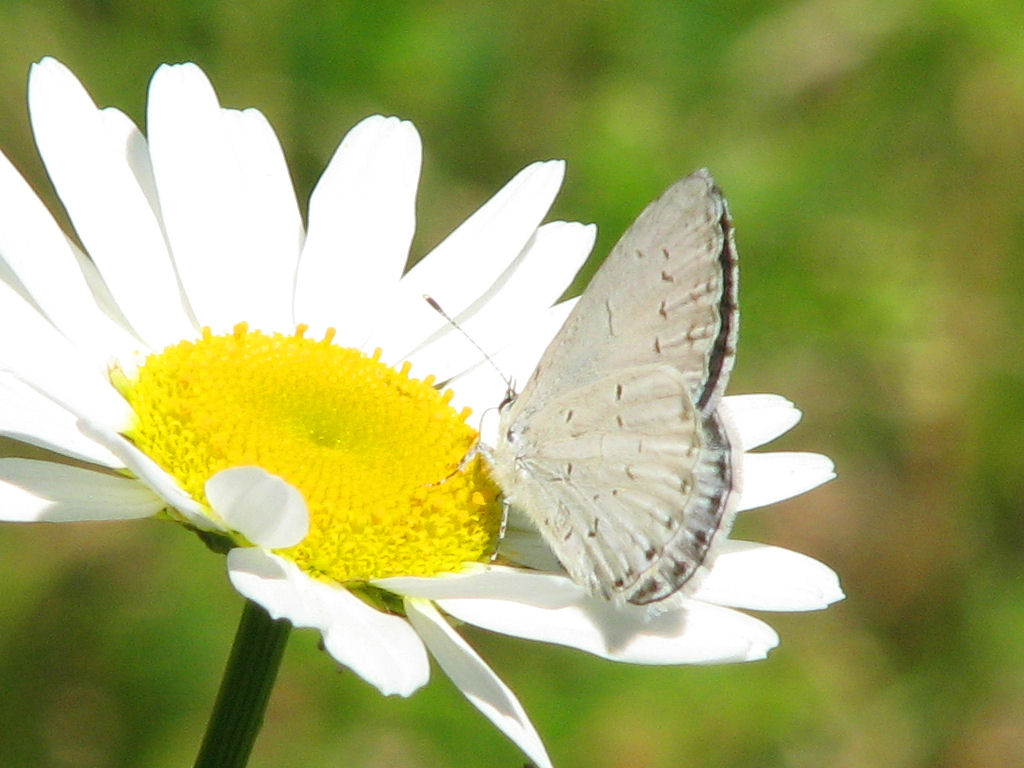
Summer Azure butterflies (Celastrina neglecta) are known for having bright colors. The dorsal color is a light blue bordered by black margins.
Its ventral color is bright gray.
Summer Azures are some of the most common butterflies in Eastern US states.
These butterflies are small as they only reach a maximum wingspan of 1.1 inches.
26. Common Buckeye

Common Buckeye butterflies (Junonia coenia) have brown wings with large eyespots.
This species is larger than Summer Azures as it can reach a wingspan of just over 2 inches.
Common Buckeyes have adapted to finding the yellow flowers that haven’t yet been pollinated to gather as much nectar as possible.
27. Eastern Comma

Eastern Comma butterflies (Polygonia comma) are larger than both Summer Azure and Common Buckeyes.
These multicolored butterflies grow to a wingspan of up to 2.5 inches.
A base orange color is specific to these butterflies. Dark brown and even black patterns and margins are further distinguishable on their wings.
This species moves out of the state before winter. It seeks warmer climates in the South.
28. Baltimore Checkerspot

Identified by its black, white, and red colors, this species of butterfly (Euphydryas phaeton) is native to Northeastern US states.
The species has a short lifespan, mainly tied to the summer months. It only flies until August.
You can find its caterpillars on plants such as English plantain. Adults feed on milkweed.
29. Fiery Skipper

This species of butterfly (Hylephila phyleus) is known for its erratic flight pattern.
It can be found all around the state since it lays eggs on grasses and common flowers. St. Augustine grass is one of the common hosts of the species.
This species can be seen as a pest in its caterpillar stages in some Southern US habitats, but not in Wisconsin.
It’s only a minor problem for lawn grasses within the state.
30. Essex Skipper

Essex Skipper butterflies (Thymelicus lineola) are also interested in grasses as hosts.
Eggs are laid on various species of grasses. Most are found on cock’s foot grasses.
Essex Skipper eggs overwinter on these grasses and emerge soon after the winter months are over.
This is one of the most common species of skipper in the entire Northeastern area of the US.
31. Hackberry Emperor

This species (Asterocampa celtis) is found on hackberry trees. Hackberry Emperor caterpillars feed on the leaves of the tree.
Adult Hackberry Emperor butterflies feed on tree sap, also from hackberry. They also eat dung.
These butterflies can also extract nutrients from puddling water.
32. Hobomok Skipper
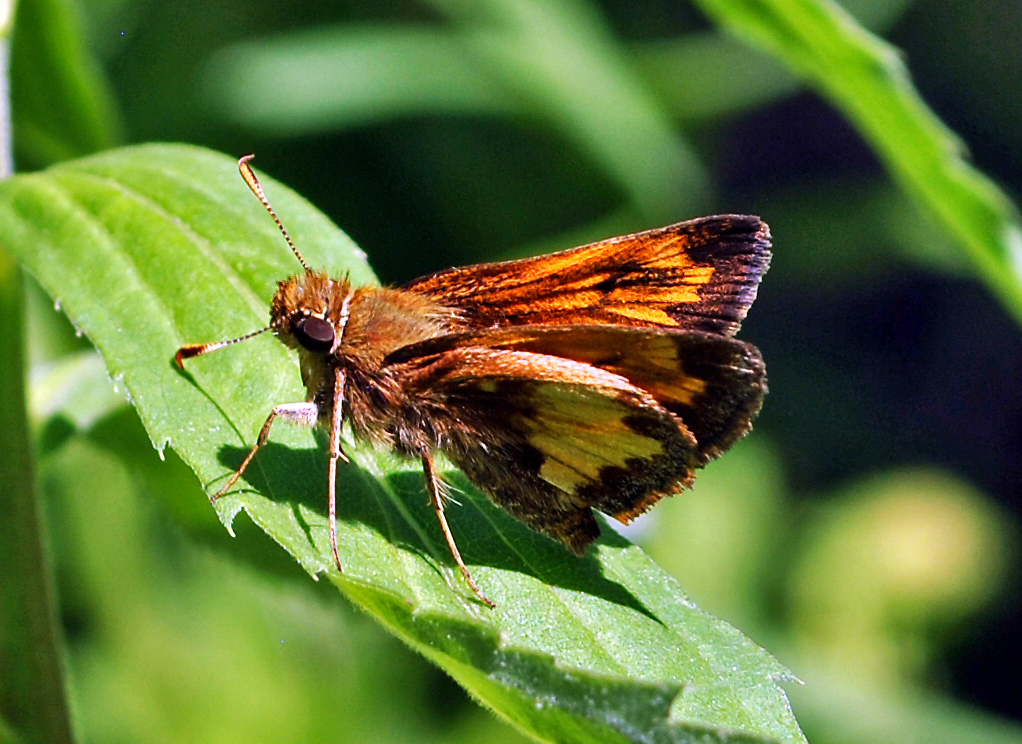
This species of butterfly (Lon hobomok) is only seen in one brood per summer.
It appears in late spring and it only flies to mid-summer.
Hobomok Skipper butterflies are seen in different habitats. They can live at the edges of woodlands or in plain open areas.
Roadsides and ditches are common habitats for the species.
33. Small Copper

Small Copper butterflies (Lycaena phlaeas) have orange forewings with brown margins. Their hindwings are brown with orange margins.
Blue spots are seen on some Small Copper female morphs.
This species is active in different habitats in direct sunlight. Male Small Copper butterflies are known for being aggressive and territorial.
They are aggressive towards other males but also towards most types of insects.
34. Juvenal’s Duskywing

Oak trees are a common host for Juvenal’s Duskywing (Erynnis juvenalis) caterpillars. The caterpillars eat the leaves of these trees, with minimum overall impact.
Adults feed on winter cress and blueberry, among other plants.
This species of butterfly is characterized by brown colors.
Light and dark brown colors are seen across the wings of this species.
Juvenal’s Duskywing butterflies grow to a wingspan of just over 1 inch.
35. Dun Skipper

Dun Skipper butterflies (Euphyes vestris) grow to a size of up to 35mm.
The species begins life as a caterpillar on sedges such as the long-stolon sedge.
It then turns into an adult of a dark brown color. It has uniform dark brown forewings and dark brown hindwings.
Some Dun Skipper Morphs also show yellow coloring, particularly on the body.
36. Aphrodite Fritillary

Aphrodite Fritillary butterflies (Speyeria aphrodite) have a base orange color with orange-brown nuances on the forewings.
This species has black patterns across its forewings and hindwings.
A single brood of Aphrodite Fritillary is characteristic of Wisconsin up until September.
You can find these butterflies around various species of violet flowers within different habitats across the state.
It uses these flowers to lay eggs on them. Adult Aphrodite Fritillary prefers milkweed over violets for nectar.
37. Canadian Tiger Swallowtail

This species of large butterflies (Papilio canadensis) makes its way to Wisconsin from the North.
It has a large wingspan that measures anywhere between 67 and 80mm.
A base yellow color is characteristic of the species.
Black stripes and black margins contrast the pale yellow color of its wings. Tiny orange spots are further seen on its hindwings.
38. Silvery Checkerspot

You can find Silvery Checkerspot butterflies (Chlosyne nycteis) on asters, dogbane, and milkweed, among other plants.
This species has the shortest lifespan within the state as it’s only active from June to July.
Silvery Checkerspots are only seen in one brood during the summer.
You can identify this species by its yellow color with black checkerspot marks and large black sections across its forewings.
39. Question Mark

Question Mark butterflies (Polygonia interrogationis) are known to mimic dead leaves. Their dark brown ventral coloring makes them appear like dead leaves whenever their wings are closed.
This is a medium-sized species that grow to a wingspan that measures anywhere between 1.8 and 3 inches.
You can occasionally see the species across the state up to September.
40. Orange Sulphur
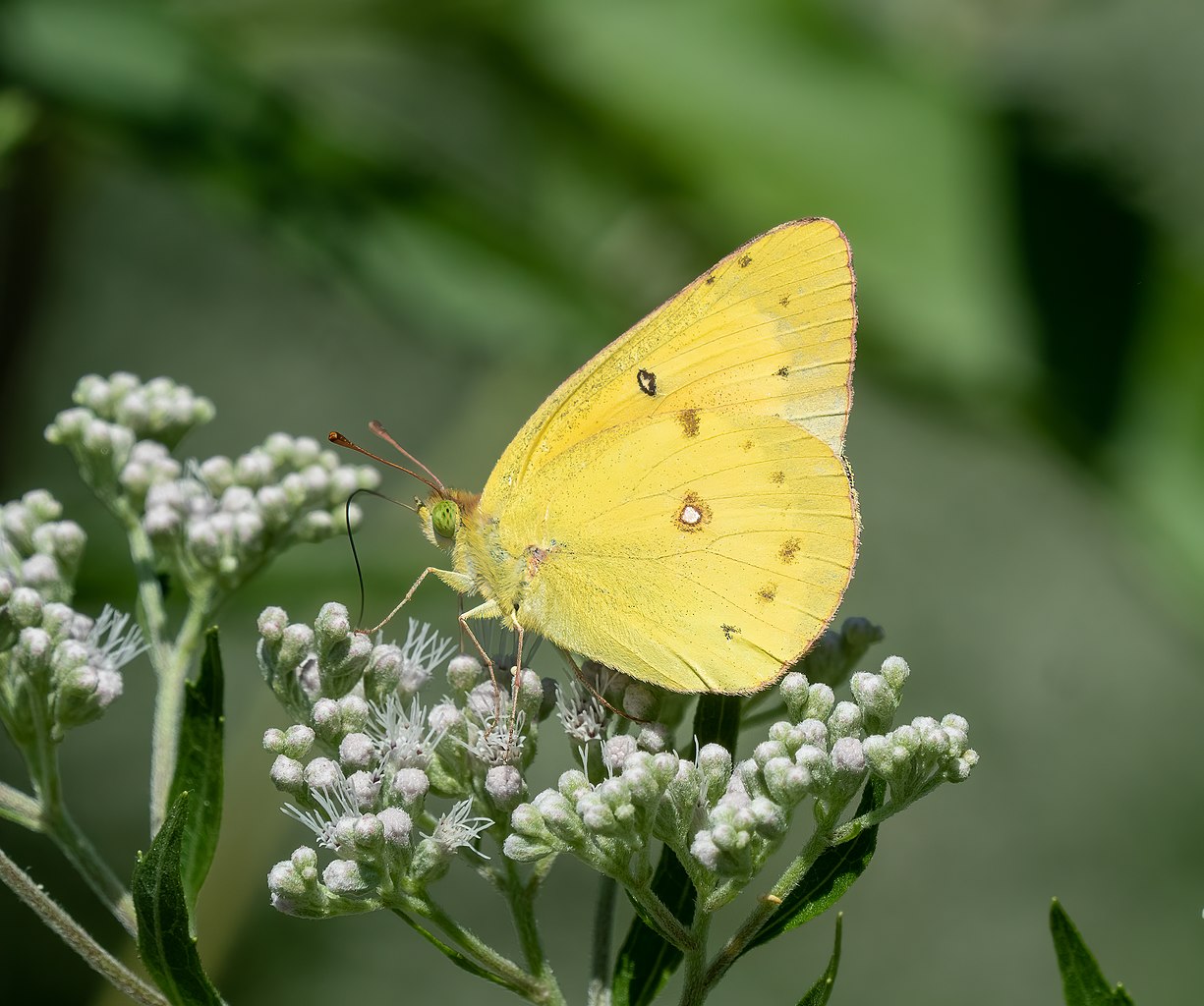
Orange and yellow colors are specific to the inner wings of the Orange Sulphur (Colias eurytheme).
Its forewings have brown-black margins.
Seen as a pest on alfalfa crops, this is one of the species known for being a minor pest as a caterpillar.
Adults are famous for having ultraviolet reflective dorsal wings.